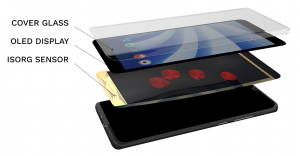By Anne-Françoise Pelé
Fingerprint biometrics have become a standard security feature on smartphones, but consumers demand more from technology to securely make online shopping, banking transactions, and bill payments. For France-based Isorg SA, multi-finger authentication is the next phase in smartphone identity recognition.
At this year’s Consumer Electronics Show, Isorg is demonstrating a full-screen fingerprint-on-display sensor module for multi-finger smartphone authentication. It supports up to four fingers simultaneously touching a smartphone display.
More fingers, more secure
A spin-off from the CEA-Liten research institute in 2010, Isorg has developed the organic photodetector (OPD) technology, which integrates printed photodiodes on different substrates to enable large-area image sensors. It is compatible with plastic or glass substrates using TFT technology or CMOS image sensors.

In response to OEMs’ and end-users’ demand for a higher level of smartphone security and privacy, Isorg designed a fingerprint-on-display (FoD) module that supports one- to four-finger authentication across the entire dimensions of the 6-inch smartphone display, or even larger. Such multi-finger authentication capability aims to strengthen security for mobile banking and payments, personal health monitoring, and remote home control applications.
Why four fingers, and not five? “The logic behind ‘more fingers, more secure’ lies in the fact that the more fingers, the more fingerprint data to be matched, making it more complex to crack,” Jean-Yves Gomez, Isorg’s CEO and co-founder, told EE Times. Five-finger authentication is possible; however, “we promote four fingers instead of five because it is more user-friendly. It is easier to enroll your index to small fingers at the same time; while adding your thumb, you have to adjust your hand position.”
Flexible and foldable displays
Isorg’s FoD module is compatible with flexible and foldable displays for smartphones and wearables. “It supports curved-edged phone displays with flexible polyimide-substrate sensors, and this slim fingerprint module is thinner than 300 µm,” Gomez confirmed. “These advantages made it easily integrated into slim smartphone and foldable displays.”
Isorg’s module can be used both for indoor and outdoor environments, as it demonstrates “robust performance under various conditions, including sunlight, web, and dry fingers as required by smartphone OEMs in different test conditions,” he said.
Designed for smartphones, the full-screen FoD module could be extended to other applications such as wearables, tablets, and other similar under-display applications. The technology can also find applications in the biometrics industry (e.g., access control, border control).
The French startup said it will be sampling its FoD module to smartphone OEMs in spring 2020. Asked when we should expect to see the first smartphones implementing this module available on the market, Gomez said, “Our lead customers who are developing new smartphones are aiming to launch their products soonest. The exact new product launch will be decided by the customers based on their marketing strategy.”
Mass production in 2020
“2019 marked an important revolution for Isorg,” said Gomez. “We integrated other skills because the company has developed its own optics components and ICs for sensors. The journey we embarked on has brought us to where we wanted.”
Back in 2018, Isorg raised $26.6M (€24M) in Series C financing to conduct the different qualification steps of its production site based in Limoges. Two years later, “we are delighted to announce that the company is fully ready for mass production of our solution within 2020. We have had our products ready for commercialization and market expansion.” On the Limoges site, Isorg has a Gen 3.5 (780 × 650 mm) manufacturing line for image sensor production with supply of TFT backplane.
Headquartered in Grenoble, Isorg has a pilot line and a dedicated application team at the CEA-Liten institute. The startup also runs a small R&D line, compatible with 8-inch silicon wafers in Bordeaux, as well as sales and application offices in Hong Kong.
Isorg owns more than 60 patents and employs 70 people.



